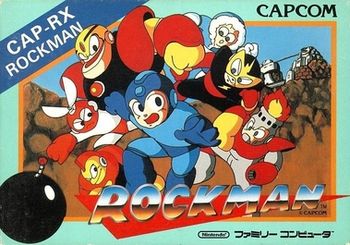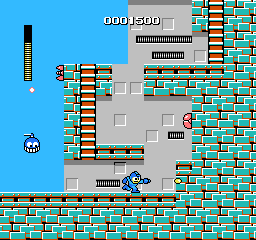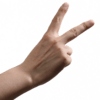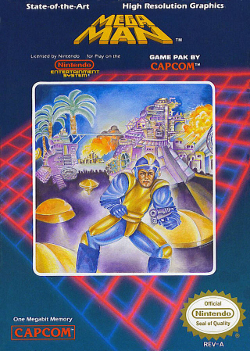Mega Man (1987 video game) facts for kids
Quick facts for kids Mega Man |
|
|---|---|

Japanese cover art with Mega Man and the six Robot Masters
|
|
| Developer(s) | Capcom |
| Publisher(s) | Capcom |
| Director(s) | Akira Kitamura |
| Producer(s) | Takashi Nishiyama |
| Programmer(s) | Nobuyuki Matsushima |
| Artist(s) |
|
| Composer(s) | Manami Matsumae |
| Series | Mega Man |
| Platform(s) | NES, PlayStation, Mobile phone, Android, iOS |
| Release date(s) |
December 17, 1987
Famicom / NES
|
| Genre(s) | Platform |
| Mode(s) | Single-player |
Mega Man, also known as Rockman in Japan, is a fun platform game created by Capcom. It first came out in 1987 for the Nintendo Entertainment System (NES). This game was directed by Akira Kitamura. It's the very first game in the popular Mega Man series.
Capcom usually made games for arcades before this. But Mega Man was special because it was made just for home game consoles. A small team at Capcom worked hard to create it.
The game tells the story of a robot hero named Mega Man. He fights against the evil mad scientist Dr. Wily. Dr. Wily has taken control of six powerful "Robot Masters." In Mega Man, you get to choose which of the first six levels you want to play first. Each level ends with a big boss battle against a Robot Master. When you win, Mega Man gets a special new weapon from that Robot Master. A cool part of the game is figuring out which weapon works best against each boss. This helps you plan your strategy for future levels.
Many people liked Mega Man for its great design. It set up many ideas for how future Mega Man games would look, play, and tell stories. The game has been included in many game collections, like Mega Man Legacy Collection. It has also been released on mobile phones and can be played on emulators. In 2006, a new 3D version called Mega Man Powered Up was made.
Contents
Story of Mega Man
In the future, around the year 20XX, robots are common helpers for people. A brilliant robot designer named Dr. Light created them. But one day, these robots suddenly started attacking humans. Six special robots, called "Robot Masters," were among them. Dr. Light had built these for different jobs. They were Cut Man, Guts Man, Ice Man, Bomb Man, Fire Man, and Elec Man.
Dr. Light soon realized that his old rival, Dr. Wily, was behind the attacks. Dr. Wily had reprogrammed the Robot Masters. Dr. Light didn't know what to do. But his helper robot, Rock, was brave and wanted to help. Rock asked to be changed into a fighting robot to stop Dr. Wily. He then called himself Mega Man.
Mega Man bravely fought and defeated the six Robot Masters. He got back their main computer parts. Then, he went to Dr. Wily's secret robot factory. Dr. Wily was making copies of Dr. Light's robots there. Mega Man fought these copies and other robots made by Wily. Finally, Mega Man faced Dr. Wily himself and won. After saving the day, Mega Man went back home to his family.
When the game first came out in Western countries, the story was a bit different. In that version, Dr. Light and Dr. Wily worked together to create Mega Man and the six Robot Masters. These robots were meant to help the people of a place called Monsteropolis. But Dr. Wily got angry because Dr. Light got all the credit. He stole the Robot Masters and made them evil. Dr. Wily then made his own robot army to take over Monsteropolis. Dr. Light sent Mega Man to stop Wily and free the city.
How to Play Mega Man
Mega Man is a side-scrolling platform game. This means you move from left to right across the screen. You can choose to play the first six levels in any order you like. In each level, you control Mega Man. He fights different enemies and gets past obstacles. At the end of every level, Mega Man faces a "Robot Master" boss.
When you defeat a boss, Mega Man gets their special attack. This "Special Weapon" becomes part of Mega Man's powers for the rest of the game. Unlike Mega Man's regular arm cannon, these special weapons have limited power. You can get more power by collecting energy cells that enemies drop. Enemies also drop health cells to refill Mega Man's health.
It's smart to choose your levels carefully. Each Robot Master is weak against a specific weapon. This encourages you to play certain stages first to get the right weapon. You can also go back to levels you've already finished. Besides the Robot Master weapons, you can find a special item called the "Magnet Beam" in Elec Man's stage. This item lets you create platforms to help you get around.
After you finish all six Robot Master stages, a seventh and final stage appears. This stage is Dr. Wily's robot factory. It's made up of four connected areas. Each area has new bosses to fight. You also have to fight the six Robot Masters again in a set order. Then, you have the final battle against Dr. Wily. You need to be careful with your weapon power because it doesn't refill between these final areas.
Making the Game: Development
Before Mega Man, Capcom mostly made games for arcades. Their console games were usually just versions of these arcade games. In the mid-1980s, Capcom decided to make Mega Man just for home consoles in Japan. They wanted new, young talent for the small team. One of these new talents was artist Keiji Inafune. He had just finished college and started working on the Street Fighter game. Inafune remembered that the Mega Man team worked very hard. Their supervisor wanted the game to be perfect.
Only six people made the Mega Man game. Inafune (who was called "Inafking" in the credits) designed almost all the characters and enemies. He also drew the Japanese Rockman logo, the box art, and the instruction manual. He even turned these designs into tiny sprites (the game's characters) for the Nintendo. Inafune said, "We didn't have many people, so after drawing character designs, I was actually doing the dotting (pixelation) for the Nintendo." He added that back then, people had to do many different jobs because the teams were so small.
Inafune was inspired by the famous manga character Astro Boy when he designed Mega Man. Mega Man is blue because that color had the most shades on the NES's color palette. This helped make Mega Man look more detailed. Even though Inafune is often given credit for designing Mega Man, he says he "only did half of the job." His mentor came up with the basic idea for the character before Inafune joined. The first designs for Roll and Dr. Light were already made. The designs for Cut Man, Ice Man, Fire Man, and Guts Man were also being worked on. Inafune's first character design was Elec Man. He was inspired by American comic book characters. Elec Man has always been Inafune's favorite design. Dr. Light and Dr. Wily were designed to look like Santa Claus and Albert Einstein. Dr. Wily was meant to be a classic "mad scientist" type.
The team thought about names like "Mighty Kid" and "Rainbow Man" before choosing "Mega Man." "Rainbow" was considered because the character could change into seven colors with different weapons. The team also used a music theme for the main characters' names. The hero's original name is Rock, and his sister's name is Roll. This is a play on "rock and roll". This naming style was used for many other characters in the series later on. One early idea for the story was that Roll would be kidnapped, and Rock would have to save her. Another idea was to have a boss fight against a giant Roll near the end of the game.
The team wanted the game's movements to look like anime. Inafune explained that Mega Man's hand turns into a gun, and you can see it come out of his arm. They wanted the movements to look realistic and make sense. The gameplay for Mega Man was inspired by the game rock paper scissors. The project supervisor wanted a simple system that still offered "deep gameplay." Each weapon does a lot of damage to one specific Robot Master. Other weapons might not work well against them. There isn't one weapon that beats all the others. Mega Man was originally able to crouch, but the team decided against it. They thought it made it harder for players to know how high enemy shots would be. Naoya Tomita (called "Tom Pon" in the credits) worked on the backgrounds for Mega Man. He did a great job using the console's limited power to create detailed backgrounds.
Manami Matsumae (credited as "Chanchacorin Manami") created the music and sound effects for Mega Man. She also programmed the sound data in three months. She had to translate musical notes into computer language one by one. Matsumae found it challenging because she could only use three notes at a time. When she couldn't write songs, she focused on making sound effects.
When the game was released in America, Capcom changed its name from Rockman to Mega Man. Joseph Morici, a senior vice president at Capcom, said he changed it because he didn't like the original name. He thought "Rockman" was "horrible" and came up with "Mega Man." Capcom liked it and kept using it for the U.S. games. Some people think Capcom changed the name because they believed American kids would like "Mega Man" more.
Mega Man's Impact and Future Games
At first, Capcom's sales team didn't think Mega Man would sell well. But after a small number of copies were released in Japan, it did well enough for Capcom to quickly make an American version. For the American release, the president of Capcom U.S.A. asked for the box art to be done very quickly. So, a friend drew it in about six hours.
Keiji Inafune believed the game didn't sell as well in North America because of its box art. The art showed things not in the game. Mega Man looked like a grown man instead of a boy. His suit was yellow and blue, not just blue. He was holding a handgun, not his arm cannon. Over the years, this box art has become famous for being one of the worst game covers ever. It has been called out by many gaming websites and magazines. A canceled game called Mega Man Universe even had a playable character called "Bad Box Art Mega Man." This character later appeared in Street Fighter X Tekken.
Even with little advertising, Mega Man became popular through word of mouth. It was a "sleeper hit" – a game that slowly gains popularity. While it wasn't a huge seller at first, Capcom let the team make a sequel. Mega Man 2 came out in Japan in 1988. Many ideas that couldn't fit into the first Mega Man due to space limits were used in Mega Man 2.
Mega Man 2 was a big success. It helped make Mega Man one of Capcom's longest-running game series. Because so many people wanted it, Capcom re-released the original Mega Man in North America in September 1991. Capcom kept the same 8-bit graphics and characters from the first game in the next five games in the main series. Even though later games had more complex stories and new gameplay, the main ideas from the first Mega Man stayed the same. Mega Man 9 and Mega Man 10 even went back to the classic 8-bit look. The scoring system from the first game was not used in any of the sequels.
According to GamesRadar, Mega Man was one of the first games to let players choose their levels in any order. This was different from linear games like Super Mario Bros. or open-world games like The Legend of Zelda. GamesRadar says that Mega Man's "level select" idea influenced many modern games. This includes games with multiple missions and side quests, like Grand Theft Auto and Red Dead Redemption.
New Versions and Remakes
Mega Man has been released many times since it first came out in 1987.
- A version with better graphics and new music was part of the Mega Man: The Wily Wars collection for the Mega Drive. This collection also included Mega Man 2 and Mega Man 3.
- In Japan, a version for the PlayStation was released in 1999. It was part of the Rockman Complete Works series. This version also had new music and a "Navi Mode" that gave players hints.
- Mega Man was included in the Mega Man Anniversary Collection. This collection had nine other games from the series. It came out for the PlayStation 2 and GameCube in 2004, and for the Xbox in 2005.
- A mobile phone version of Mega Man was released in North America in 2004. A different Japanese mobile phone version came out in 2007. It was updated in 2008 to let players play as Roll.
- The NES version of Mega Man was re-released on the Virtual Console service. It came out for the Wii in 2007-2008, the 3DS in 2012, and the Wii U in 2013. The Complete Works PlayStation version was also available on the PlayStation Store.
Mega Man Powered Up
An enhanced remake called Mega Man Powered Up was released in 2006 for the PSP. In Japan, it was called Rockman Rockman (ロックマン ロックマン). This game had completely new graphics. The characters looked like 3D chibi figures, with big heads and small bodies.
Keiji Inafune had wanted Mega Man to look this way originally. But the NES hardware wasn't powerful enough. Producer Tetsuya Kitabayashi said the new character designs were made to fit the PSP's widescreen display. The bigger heads on the characters allowed the team to show their facial expressions better. Character designer Tatsuya Yoshikawa said they wanted "cute designs geared towards little kids." He also made sure to keep all the original Mega Man details.
Mega Man Powered Up has two ways to play:
- Old Style: This mode is like the NES version, but with updated graphics.
- New Style: This mode uses the PSP's full widescreen. It has story scenes with voice acting, different level layouts, and remixed music. You can also choose from three difficulty levels.
This new version also added two new Robot Masters: Oil Man and Time Man. The original NES game was planned to have eight Robot Masters, but they were cut to six because of a tight schedule. In Mega Man Powered Up, you can also unlock and play as the eight Robot Masters, Roll, and Protoman. The New Style levels are different, and some paths can only be reached by specific Robot Masters.
Mega Man Powered Up also has a Challenge Mode with 100 challenges. There's also a level editor where you can create your own stages. You can even share your custom levels online through PlayStation Network. The remake received good reviews. However, it didn't sell very well in stores. It was later released as a paid download and bundled with another game. Capcom also translated Mega Man Powered Up into Chinese for release in Asia in 2008.
See also
 In Spanish: Mega Man (videojuego de 1987) para niños
In Spanish: Mega Man (videojuego de 1987) para niños






